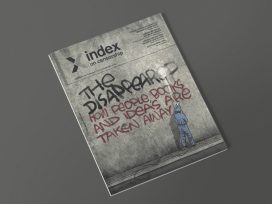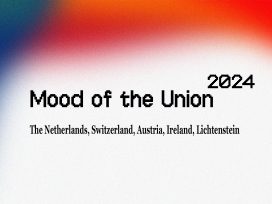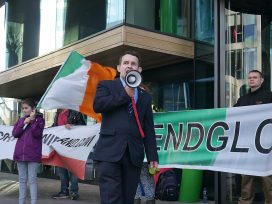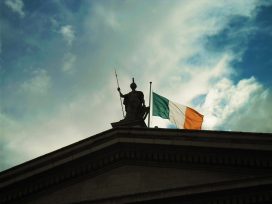‘Es gibt nicht nur eine Erzählung.’ There isn’t just one story – or there’s more than one way of telling a story, we might say. The sentiment, which is that of Monika Sommer, director of Vienna’s new contemporary history museum the House of History Austria (HdGÖ), would not of course be news to any student of Irish history, familiar as we are with revisionism (memorably caricatured by the late Breandán Ó hEithir in his spoof ballad ‘The Gentle Black and Tan’), and anti-revisionism, and the many interesting approaches that have been inspired by the tensions between the two.
One way of course of dealing with difficult or contested history is not to tell the story at all. And indeed the story of Germany between 1933 and 1945 was one that after the war not too many citizens of the new Bundesrepublik wanted to hear a great deal about. Yet even mentioning it at all was too much for some politicians: the Bavarian conservative Franz Josef Strauss, speaking in 1969, expressed the view that ‘a nation that has built an economy as strong as ours has a right not to hear about Auschwitz any more’, a sentiment many of us might consider something of a non sequitur. But in fact it was just around this time that a new generation of younger Germans, unburdened by any personal guilt and perhaps rather keen to subject their parents to hostile interrogation, began to seriously come to terms with the national socialist past (‘die NS-Zeit’). And, as they gradually made their presence felt in the institutions of the state from the 1970s onward, the way in which they carried out the necessary work of coming to terms with the past and isolating the nostalgists and far-right revivalists was exemplary. But is it all now beginning to run out of steam? The far right in Germany was certainly kept in its box for a long time, failing to cross the threshold for parliamentary representation of 5 per cent of the national vote, but in 2017 it rather suddenly became, in the shape of the Alliance for Germany (AfD) the third-largest political force in the country. One of the AfD’s leaders, Alexander Gauland, has argued that Germans, just as much as the French or British, have the right to be proud of the achievements of their soldiers (in both world wars, he emphasizes); another prominent party figure, Björn Höcke, has lamented the fact that Germany has ‘planted a memorial of shame’ (the Holocaust memorial, that is) in the heart of Berlin.
Of course the Germans are not the only ones with a difficult past. The British painted the globe pink, and sometimes red, but the history taught in school at home long seemed to be chiefly about Good Queen Bess, the Reformation (decidedly a Good Thing), important British inventions (from the Spinning Jenny to democracy) and the Second World War, in particular the phase of it where Britain stood alone against Nazi Germany; not so much was taught about what the army and colonial administrators had done in Ireland in the 1790s, in the Punjab in 1919 or in Kenya in the 1950s. History’s victims too have often wanted their story to be just right, with all the fault on one side and no troublesome grey areas. In my own secondary school history class the teacher told us to score out the passages in the (British-published) textbook that dealt with the reigns of Queen Mary (‘Bloody Mary’) and King James II (‘You don’t have to learn that.’); also to delete the word ‘Roman’ every time the epithet ‘Roman Catholic’ was used (‘There’s only one kind of Catholic!’ he thundered.)
In Germany’s neighbour Austria, which was incorporated into the Reich from 1938 to 1945, (at least) two versions of history are current, one in which the country was a victim of Nazi aggression and one in which it was largely a willing, even enthusiastic, accomplice of Germany’s ambition for ‘greatness’ and an equal participant in its war crimes and crimes against humanity. The filmmaker Billy Wilder, born in 1906 to a Jewish family in what was then the multinational state of Austria-Hungary, remarked that the Austrians (he meant the post-Second-World-War Austrians) were a clever people who had managed to persuade the world that Beethoven and Mozart were Austrians while Hitler was a German. (Beethoven was from Bonn but made his name in Vienna; Mozart was from Salzburg, not an Austrian territory during his lifetime; Hitler was born in the Austrian border town of Braunau.) This is very probably a witticism that Austrians are heartily sick of but it does have a certain validity. And one can understand where Wilder was coming from: his mother, stepfather and grandmother died in the Holocaust.
Visiting Vienna over several days in early November I began after a while to notice a contrast between what I was seeing on the street and the images of the nation that television (or at least some TV stations) seemed to be promoting. Like many capital cities, Vienna has a multiethnic population, and the non-ethnic-European element of this can be particularly noticeable on public transport; among all the tired people there are many ‘Austrians’ of course, but also a very large number who are ethnically Turkish or Moroccan or Syrian, on their way home by Metro at the end of a hard day’s work. This significant element of the population seems to be less visible on television, where some channels at least like to treat the viewer rather lavishly to a vision of wholesome Austrianness, a condition that seems to involve blond plaits, traditional costumes (Tracht), horses and livestock festooned with flowers, orange pumpkins, bright berries and red apples, village bands and traditional processions to the parish church, where a portly soutaned priest shakes holy water over all and sundry and traditional hymns and carols are intoned in sweet childish voices. This idyll, which is not unconnected with the cult of genuine, organic, whole food, takes place of course not in Vienna but in places a few hundred kilometres to the west and southwest where the air –and not just the air – is pure and the hills are alive. As cultural conservatives never tire of reminding us, Vienna is not Austria (just as Paris is not France, London not England, Berlin not Germany and Dublin not Ireland).
The state which was established just over a hundred years ago as the Austro-Hungarian empire disintegrated (and which the House of History Austria’s opening date in November commemorated) was originally called the Republic of German-Austria (Republik Deutsch-Österreich). It had been remarked before the war that everyone, every subject of the old emperor, Franz-Joseph, was increasingly a something-Austrian, that is to say a Czech Austrian, a Slovenian (or Yugoslav) Austrian, a Polish Austrian etc. The only ones who were – in a sense – simply Austrian, who had nowhere else to go, were the Jews and the German-speakers, although these latter tended also to have regional identities (Tyrolean, Carinthian, Styrian etc) that were perhaps as strongly felt as their Austrianness, which often took second place to their Germanness. The social democrat Otto Bauer described the new state as ‘a loose bundle of divergent lands’. Most ‘new Austrians’ felt it could not be viable on its own and wanted union with Germany. But it emerged clearly in 1919 that the Western Allies, the Entente, were firmly opposed to and would veto any such union. In October 1919 the country changed its name to the Republic of Austria, having now also lost the Sudetenland and German Bohemia to Czechoslovakia, South Tyrol to Italy and parts of Carinthia and Styria to Yugoslavia.
The shrunken territory of the Republic of Austria looked unlikely to provide the means of survival for its population. Though blessed with much fine scenery, it was notably deficient in good agricultural land. It was also deeply divided, between a conservative countryside and a radical capital (‘Red Vienna’), a political division that still, broadly speaking, exists even if Vienna is not quite as red as it once was. Throughout the 1920s, civil unrest was common. After 1920 the dominant political force was the Christian Social Party, with its strong ties to the Catholic church. Those who believe that Ireland in the twentieth century was a society which was uniquely ‘priest-ridden’ may be surprised to learn that the chancellor of Austria from 1922 to 1924, and again from 1926 to 1929, was a Catholic priest, Fr Ignaz Seipel. After eighty-nine demonstrators were killed by the police during disturbances in Vienna in July 1927, Seipel became known to his social democrat opponents as ‘the bloody prelate’.
By 1933, democracy had disappeared in Austria, with Chancellor Engelbert Dollfuss setting up a non-parliamentary regime of a clerical-corporatist character (in opposition to the Austrian Nazis, who also had very significant support in the country at the time). In the following year Dollfuss was assassinated by the Nazis and succeded by his colleague Kurt Schuschnigg, who ruled until the German annexation of Austria (Anschluss) in 1938. Schuschnigg survived wartime internment and emigrated to the United States in 1948, working as an academic.
The idea of the House of History has been in the works for quite some time, at least twenty years. Director Sommer, in an interview with Der Standard on November 4th, explained that the ambition of the museum was to be a house of contemporary history, of the events that have shaped the present. The story begins with the declaration of a republic based on progressive and social principles one hundred years ago, though also with a look back into the development of democratic ideas in Austria-Hungary since 1848. It continues through the years of violent class conflict, ‘clerico-fascism’ and national socialism, the 1938 Anschluss and the war, the postwar four-power occupation and the eventual restoration of full independence in 1955, taking in the rise of a powerful new extreme right movement in the 1980s under Jörg Haider; the inheritor of Haider’s mantle, Freedom Party (FPÖ) leader Heinz-Christian Strache, is today Austria’s vice-chancellor and the party has several ministerial portfolios, including the interior ministry, in the current Austrian People’s Party (ÖVP)-Freedom Party coalition government.
History remains a disputed matter in Austria – the clericalists Dollfuss and Schuschnigg still have their defenders, or at least those who ask us to consider the circumstances (opposed by an insurrectionary left and the Nazi right) in which they were operating. And so it is scarcely a surprise that the project of establishing the House of History was subjected to so many delays and was accompanied by so many changes of plan. In its current form it is considerably smaller than was envisaged just a few years ago and its future governing structure is also uncertain. Culture minister Gernot Blümel (ÖVP) has spoken of the possibility of making the museum a ‘House of the Republic’ and tying it organizationally to parliament. Monika Sommer, naturally, would prefer a constitution which would see the museum as a free-standing institution with an independent board of scholars and other experts supervising content and presentation.
In Vienna for Eurozine’s annual meeting of European cultural journals in early November I stayed on after its finish for another few days to renew my acquaintance with the city and in particular to do some wandering away from the precincts most visited by tourists. The areas of Mariahilf, Neubau and Josefstadt lie just to the west of the city centre. Mariahilferstrasse is Vienna’s main popular shopping street and home to all the familiar retailing chains which are the same in every European capital or large city. When one heads north towards Neubau and Josefstadt, however, one comes across smaller shops and businesses, hundreds of them in fact: cafes, furniture and design shops, toyshops (model railways a favourite), opticians, dress shops, shoe shops, bookshops. The population of Neudorf is a relatively young and educated one, yet what we are seeing in the commercial profile of its streetscape does not quite, as one might be tempted to think, represent the total triumph of the hipsters. Traditional businesses – the butcher and the baker, and if not the candlestick-maker, certainly the plumber and heating engineer and the electrical goods dealer are here too. And of course one of the reasons why there is so much life and business in these areas is that large numbers of people live there, in apartments in the large blocks (mostly nineteenth century buildings) of which retail occupies just the ground floor. And another reason all this is possible, one must assume, is that the local councils, in which both social democrats and (particularly) Greens are well-represented, implement policies that are pro-citizen rather than merely pro-business or ‘pro-investment’. Thirty-two thousand people live in Neubau, that is a population density of 20,000 to the square kilometre. The average population per square kilometre in Dublin city is around 3,500; in fact the greatest densities in the Greater Dublin Area (up to 5,000) are to be found not close to the heart of the city but in newer developments in Fingal.
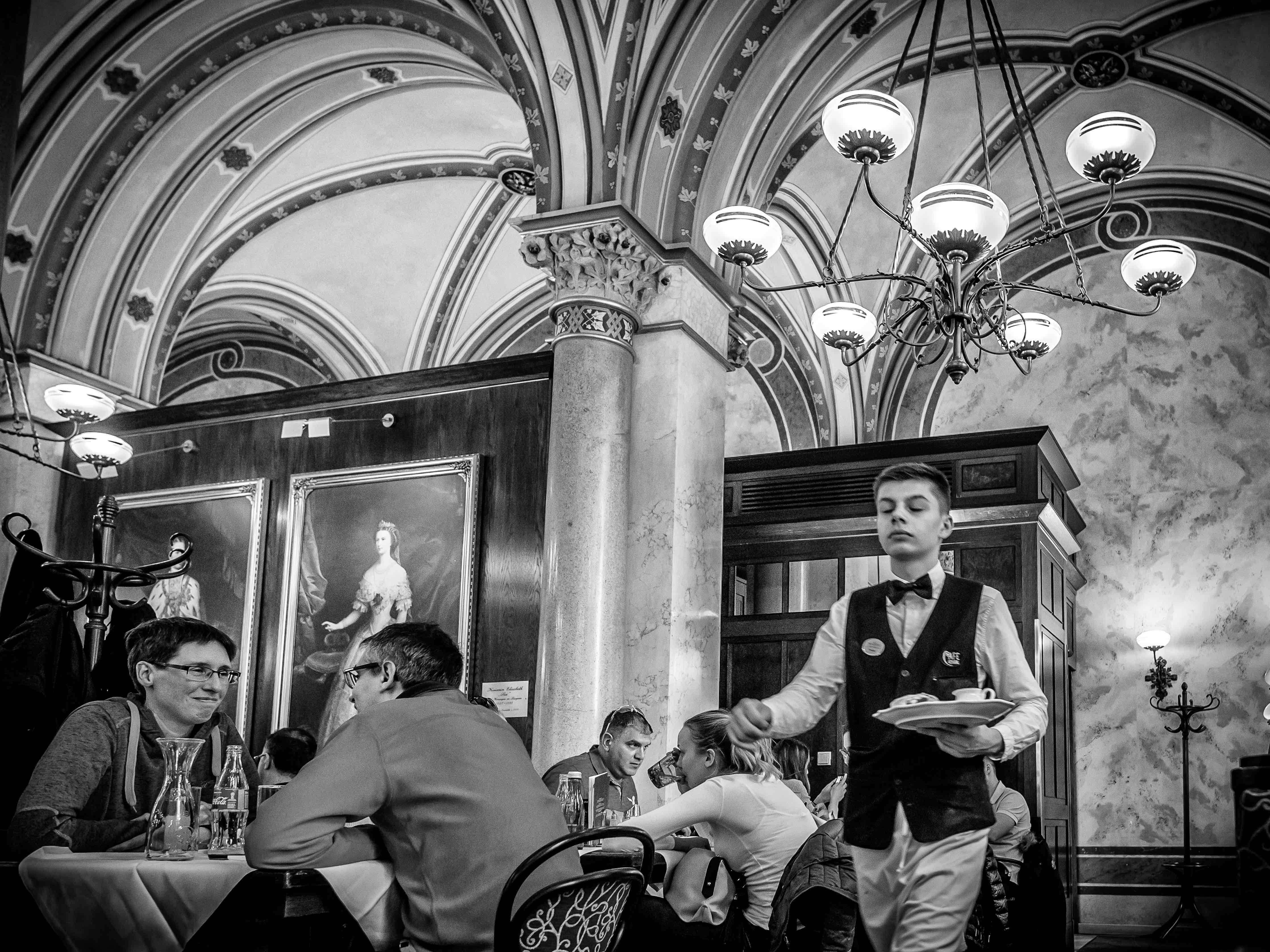
Cafe Central Vienna (2018). Photo by Heinz Bunse on Flickr
If Dublin is known for its pubs and pub life, one of Vienna’s main attractions for visitors is its cafes, the most famous of which, once patronized by the writers and intellectuals of the Belle Époque, are closer to the Ring which encloses the Innere Stadt. Here, in establishments like the Café Central, the Bräunerhof and the Griensteidl (regrettably closed in 2017), writers like Hugo von Hofmannsthal, Arthur Schnitzler, Stefan Zweig and Karl Kraus would drink coffee, read the newspapers and periodicals of the day and hold forth on philosophy, aesthetics and politics. And not just hold forth: they also wrote … a lot. Many contemporaries have recalled the brilliant, inventive conversational riffs of the major star of our 1950s Dublin pub culture, Brendan Behan. Sadly not a great deal of this brilliance made its way into print, a hazard perhaps of developing intellectually in a pub rather than a cafe culture.
Turn-of-the-century Vienna was also of course the city of the psychoanalyst Sigmund Freud, the modernist composer Arnold Schoenberg, the painters Gustav Klimt and Egon Schiele and the architects and designers Otto Wagner and Josef Hoffman. No visitor to Vienna is likely to be left unaware of the visual heritage left by these latter. And many of the cafes are still there too, even if the clientele is today perhaps more bourgeois than bohemian. They are comfortable places. You can order anything you like, small or large ‑ a glass of wine, an omelette with salad or a Wiener Schnitzel, coffee with Linzertorte and extra cream – and you can stay as long as you like. The waiter, polite and discreet, will guide you to a red plushbanquette and take your overcoat to hang up, and he could probably tell you to within twenty euro how much you paid for it too. There is something about Vienna that is very comfortable and also something that encourages nostalgia. The thing that has gone, the thing that is missed, is of course the old Habsburg Vienna. And yet it doesn’t actually feel as if it’s completely gone. Half-way through the Second World War the Hungarian writer Sándor Márai published a novel (translated into English as Embers) in Budapest that recalled a youth spent in the capital of the empire in the last days of Franz-Joseph (1830-1916). The point of view is that of Henrik, a young officer cadet:
Everything was peaceful. Vienna was sound asleep under the falling snow. The Emperor was asleep in the Hofburg and fifty million of his subjects were asleep in his lands. [Henrik] felt that this silence was also in part his responsibility, that he, too, was keeping watch over the sleep and safety of the Emperor and his fifty million subjects, even when he was doing no more than wearing his uniform with honor, going out in the evening, listening to waltzes, drinking French red wine, and saying to ladies and gentlemen exactly what they wished to hear from him. He felt that he obeyed a strict regime of laws, both written and unwritten, and that this obedience was also a duty which he fulfilled in the salons just as he fulfilled it in the barracks or on the drill ground. Fifty million people found their security in the feeling that their Emperor was in bed every night before midnight and up again before five, sitting by candlelight at his desk in an American rush-bottomed chair, while everyone else who had pledged their loyalty to him was obeying the customs and the laws. Naturally true obedience required a deeper commitment than that prescribed by laws. Obedience had to be rooted in the heart: that was what really counted. People had to be certain that everything was in its place …
… As he sauntered past the shops in the center of the city in the company of other strollers, he would occasionally be greeted by a waiter or the driver of a hansom cab because he looked so like his father. Vienna and the monarchy made up an enormous family of Hungarians, Germans, Moravians, Czechs, Serbs, Croats, and Italians, all of whom secretly understood that the only one who could keep order among this fantastical welter of longings, impulses, and emotions was the Emperor … Vienna was in high, good mood. The stuffy high-vaulted taverns in the old city served the best beer in the world, and as the bells chimed midday the streets filled with the rich smells of goulash, spreading friendliness and good will as if there were eternal peace on earth.
As we know, there was not to be eternal peace on earth. One and a half million of these Hungarians, Germans, Moravians, Czechs, Croatians, Bosnians and others died between 1914 and 1918 in a doomed attempt to salvage the honour of the empire on the battlefield. And those who survived for the most part gave up on Austria and its splendid capital. Not all, however, it seems. Wandering around the streets of central and west-central Vienna one can spot, among the names above the shop windows, frequent indications that in spite of the declaration of a Republic of German-Austria in 1918 not all of those who didn’t strictly qualify as German were inclined to ‘go back where they came from’. Trnkóczy, Horak, Trześvilnski, Bascha, Hawelka, Junek … no, none of these names sound exactly echt deutsch. Out-of-town origins are evident too in the names of the four social democratic Austrian chancellors who succeeded each other from 1970 to 2000: Bruno Kreisky (Czech-Jewish family background), Fred Sinowatz (ethnic Croatian), Franz Vranitzky and Viktor Klima (both Czech family names).
So Austria, in particular the Austrian capital, has been a melting pot over the last hundred years for citizens of diverse European (chiefly German, Slav and Magyar) origins. Can it be the same in the future for new citizens of non-European origin? Well, not if the Freedom Party has anything to do with it. A FPÖ poster displayed in the House of History features the party slogan ‘Fremd in eigenem Land’ (a foreigner in your own country). The notion is commonplace enough. Virtually identical words – and others more inflammatory – were used by Enoch Powell in his infamous 1968 Birmingham speech on immigration into Britain. For the Austrian Freedom Party the slogan is perhaps meant to conjure up among Austrian-Austrians the fear that the working class immigrant women who clean their floors and who will one day wipe their bottoms in the Altersheim could become the dominant force in the country and that blond plaits, perhaps, will be banned by law. Other FPÖ slogans have included ‘Pummerin statt Muezzin’ (Pummerin [the main bell of St Stephen’s Cathedral] not the [Muslim] call to prayer); ‘Daham statt Islam’ (Our own folk, not Muslims); ‘Deutsch statt ‘nix verstehen’’ (German not ‘doanunerstand’). A few decades back Jörg Haider, campaigning on a law and order ticket, had used the slogan ‘Wien darf nicht Chicago werden’ (Vienna must not become Chicago). The current FPÖ leader, Heinz-Christian Strache, has sharpened the message for our current decade, in which more things can be said and sneering and racial hostility can be expressed more openly and with impunity: ‘Wien darf nicht Istanbul werden.’ And if anything can be said, perhaps also, ultimately, anything can be done. We have been this way before.
Monika Sommer, asked in the Der Standard interview what we can learn today from the history of the first Austrian republic, replied: ‘That we must every day take cognisance of the fact that democracy and the rule of law are perishable things. History shows how they can be abolished step by step. We can also learn where polarization and radicalization, which always begin with speech, can lead to. It’s time to realize that the nature of our public speech says a lot about the overall condition of our society.’
